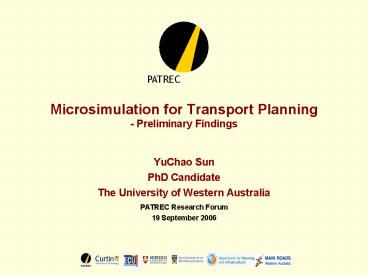Microsimulation for Transport Planning Preliminary Findings PowerPoint PPT Presentation
1 / 25
Title: Microsimulation for Transport Planning Preliminary Findings
1
Microsimulation for Transport Planning-
Preliminary Findings
- YuChao Sun
- PhD Candidate
- The University of Western Australia
- PATREC Research Forum
- 19 September 2006
2
Contents
- Overview of microsimulation AIMSUN (video demo)
- Modelling building
- Model
- Testing
- Concluding remarks (video demo)
3
Overview of Traffic Microsimulation
- ABM (Agent Based Modelling)
- Discrete Time
- Stochastic (Give confidence interval rather than
point estimate) - Bottom-up
4
The Software
- AIMSUN NG (www.aimsun.com)
- User Friendly GUI
- objects colouring
- adjustable recordable animation
- tracking individual vehicles display floating
data - Fast network building editing
- unlimited number of links and vehicles
- Open Platform
- User-defined functions
- API
- SDK
- Computationally efficient
- Parallel computing with multiple threads
- Rich data outputs
5
Required Data
- Vehicle parameters
- Length
- Acceleration deceleration rate
- Desired speed
- Speed acceptance
- Give-way time
- Etc.
- Road parameters
- Capacity
- Speed limit
- Geometry
- Etc.
6
Required Data (Contd)
- Traffic control
- Fixed, actuated adaptive signal controls
- Warning signs
- Ramp metering
- VMS, etc.
- Public transport data
- Traffic demand (O/D matrix or turning
proportions) - Detectors
7
Transforming Macrosimulation Model
- Import shape files
- O/D matrices
- Traffic flow directions
- Lane numbers
- Connectors
- Curved Segments
8
Transforming Macrosimulation Model (Contd)
9
Transforming Macrosimulation Model (Contd)
10
Transforming Macrosimulation Model (Contd)
11
Transforming Macrosimulation Model (Contd)
- Junctions
- Control Plans
- Centroids
- Vehicle data
12
Transforming Macrosimulation Model (Contd)
13
Transforming Macrosimulation Model (Contd)
14
Transforming Macrosimulation Model (Contd)
15
The Model
16
Calibration
- Visual inspection
- Because of the unavailability of data, proper
calibration could not be carried out - Because of time constrains, insufficient number
of replications have been run - So the following tests are only used to
demonstrate the possible applications
17
Section Performance
18
Section Performance
19
System Performance Measures
- Mean Flow Average number of vehicles passed
through the network per hr - Density Average number of vehicles per km for
the whole network. - Mean Speed Average speed for all vehicles that
have left the system. - Travel Time Average time a vehicle needs to
travel 1km inside the network. - Delay Time The average difference between the
expected travel time (under ideal conditions)
the actual travel time /veh/km.
20
System Performance Measures
- Stop Time average time at standstill /veh/km
- Number of Stops average number of stops /veh/km
- Total Travel total number of kms travelled by
all vehicles left the network - Total Travel Time total travel time experienced
by all vehicles left the network.
21
Testing AlternativesVehicles with better or
worse info.
22
Testing AlternativesVehicles with better or
worse info.
23
Decision Table
24
Concluding Remarks
- Microsimulation models for large urban area such
as Perth CBD are not only feasible but also
beneficial (for both academics practitioners) - One model can serve multiple purposes an
integrated approach of planning management
across different department - There are more parameters in microsimulation
models so a systematic approach is essential for
calibration and validation. - Transforming macrosimulation models can speed up
the process, but the analysts should be aware of
some methodological problems.
25
Concluding Remarks
- Although require more data, microsimulation
models also produce more insights on how traffic
evolves, e.g. time series data, sensitivity
analysis, confidence interval estimate, etc. - Although not calibrated, the model seems to
suggest better information does not necessarily
lead to better traffic conditions. This at least
provides some words of caution to possible ITS
applications. - Thanks Questions?
- ?
- suny02_at_biz.uwa.edu.au

